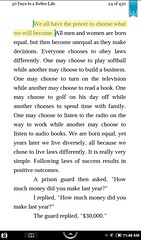1993: I am a freshman in high school, a newly avid reader just discovering a world of books. I haunt the local used books stores looking for titles by my favorite authors and discovering new ones to try. This is a solitary pleasure until one day, visiting a friend, I see some of my beloved books on his shelf. Soon we are trading books, haunting the same bookstores, by chance having become a tiny, two-person audience for our favorite authors.
Most cultural forms aggregate their audience into a common physical space. For example, films and theater bring people together into a viewing space. Art is typically viewed in common spaces in the company of others. Music is often consumed via a live performance, in a concert setting.

Some rights reserved by xJason.Rogersx
Interestingly, while we now increasingly have de-aggregated the audience for these other cultural forms—thanks to an explosion in technology that has allowed for sophisticated theater and stereo systems to be had at a relatively affordable price in the comfort of our homes—books are moving in the other direction. Long a form consumed in a solitary fashion, books are now aggregating their audiences. But this isn’t entirely new. How have books and stories sometimes aggregated an audience? – In pre-book times, stories were an oral tradition, with an audience of listeners. – Following the advent of a written tradition, scholars discussed important texts in many eras through history, adding and sharing commentaries and marginalia. These were a feature of scholarship in Classical Antiquity and the Middle Ages and were important to the rediscovery of Classical works by the humanists during the Renaissance (Greenblatt 2011). – Growing out of a salon tradition developed in Europe during the Renaissance, authors would read from their work to small groups. – This tradition of public readings has become a staple in bookstores and certain academic settings, and have evolved in some places to become almost a performance art, including readings in public places and marathon readings of long books. [youtube youtubeurl=”Le0pLSFLkkQ” ][/youtube]
Now, the advent of technology has enabled the aggregation of audience around books like never before. Social networks and online communities have made it trivial for fans of certain books and authors to form ad hoc (or even “official”) communities around the work they care about. A book may have a large distributed but connected “audience” creating a social reading experience that can manifest in a variety of ways, including:

Some rights reserved by Technipages
– Having easy access to the commentary of others, aggregated and depersonalized as in “most highlighted passages” keyword tagging and other crowdsourcing of metadata. – The proliferation of online communities where vigorous books discussions can occur over email listservs, on message boards, in Facebook groups, in the comment sections of blog posts, and even on Twitter. – There have long been publications writing about and offering critiques of books in a one-to-many fashion, but many of those same publications, now online, have tools like comment sections that allow their readers to congregate and join the discussion. – The creation and sharing and swapping of fanfiction (which interestingly is a phenomenon hardly limited to the world of books, with writers commonly riffing on movies, TV shows, and even real-world events and people.)
There is great potential in how publishers and book communities can continue to look for ways to use technology to aggregate audiences around books. What may be missing is an open-source venue to facilitate and house these communities. It should be simple for readers to easily find and interact with the aura of information and reaction that may surround any book. Each book has the potential to be a mini-community of its own.

